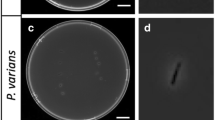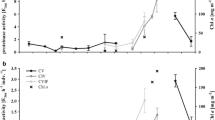Abstract
Protistan community grazing rates upon both bacterioplankton and autotrophic picoplankton were estimated using fluorescently-labeled prey and by measurement of extracellular hydrolysis of 4-methylumbelliferyl (MUF) β-N-acetylglucosaminide in a eutrophic reservoir and an oligo-mesotrophic lake during phytoplankton blooms. In addition, enzyme methods were optimized in bacterivorous flagellate cultures by two enzyme assays, based on fluorometric detection of protistan digestive activity, which were compared and calibrated independently against flagellate bacterivory. Enzymatic hydrolyses of MUF β-N,N′,N″-triacetylchitotriose and MUF β-N-acetylglucosaminide were measured in cell-free (sonicated) and whole-cell (unsonicated) samples. The hydrolysis of both substrates, using the whole-cell enzyme assay at in situ pH, was correlated significantly with total grazing rate of Bodo saltans. Thus the whole-cell enzyme assay with MUF β-N-acetylglucosaminide was used for freshwater samples. High-affinity (K m < 1 μmol 1−1) and low-affinity (K m > 100 μmol 1−1) enzymes were distinguished kinetically in most samples from both systems studied. Activities (V max ) of the high-affinity enzyme varied from 0.24 to 1.43 nmol 1−1 h−1. Protistan community grazing on bacterioplankton was in the range of 0.15–1.36 μg C 1−1 h−1. both for lake and reservoir, the differences being observed in grazing on picocyanobacteria (lake, 0.03-0.22 μg C 1−1 h−1. reservoir, 0.35–1.56 μg C 1−1) h−1. The enzyme activities were correlated significantly with the protistan grazing both on bacterioplakton (r s = 0.62, P < 0.001) and total procaryotic picoplankton (the sum of organic carbon grazed from bacteria and picocyanobacteria, r s = 0.73, P < 0.001) in the eutrophic reservoir. Weaker relationships (r s = 0.42) with a lower slope were found for the oligo-mesotrophic lake. Ingestion rate studies are time-consuming and the digestive enzyme assay with MUF β-N-acetylglucosaminide presents a rapid alternative for estimating total protistan prokaryotic picoplanktivory in freshwaters.
Similar content being viewed by others
References
Azam F, Fenchel T, Field JG, Gray JS, Meyer-Reil LA, Thingstad F (1983) The ecological role of water-column microbes in the sea. Mar Ecol Prog Ser 10:257–263
Berninger UG, Finlay BJ, Kuuppo-Leinikki P (1991) Protozoan control of bacterial abundances in fresh water. Limnol Oceanogr 36:139–147
Bertocchi C, Navarini L, Cesaro A, Anastasio M (1990) Polysaccharides from cyanobacteria. Carbohydr Polym 12:127–153
Burns CW Stockner JG (1991) Picoplankton in six New Zealand lakes: abundance in relation to season and trophic state. Int Rev ges Hydrobiol 76:523–536
Düring K (1993) Can lysozymes mediate antibacterial resistance in plants? Plant Mol Biol 23:209–214
González JM, Sherr BE Sherr EB (1993) Digestive enzyme activity as a quantitative measure of protistan grazing: the acid lysozyme assay for bacterivory. Mar Ecol Prog Ser 100:197–206
Holz GG Jr (1973) The nutrition of Tetrahymena: Essential nutrients, feeding, and digestion. In: Elliot AM (ed) Biology of Tetrahymena. Dowden, Hutchinson & Ross, Inc., Stroudsburg, pp 89–98
Hoppe HG (1983) Significance of exoenzymatic activities in the ecology of brackish water: measurements by means of methylumbelliferyl substrates. Mar Ecol Prog Ser 11:299–308
Jumars PA, Penry DL, Baross JA, Perry MJ, Fros BW (1989) Closing the microbial loop: dissolved carbon pathway to heterotrophic bacteria from incomplete ingestion, digestion, and adsorbtion in animals. Deep-Sea Res 36:483–495
Landry MR (1994) Complementary methods and controls for measuring the grazing impact of planktonic protist. Mar Microb Food Webs 8:37–57
Nedoma J, Vrbá J, Hejzlar J, Šimek, K, Straškrabová V (1994) N-acetylglucosamine dynamics in freshwater environments: concentration of amino sugars, extracellular enzyme activities, and microbial uptake. Limnol Oceanogr 39:1088–1100
Norland S (1993) The relationship between biomass and volume of bacteria. In: Kemp PF, Sherr BF, Sherr EB, Cole JJ (eds) Handbook of methods in aquatic microbial ecology. Lewis Publishers, Boca Raton, pp 303–308
Pechlaner R (1979) Response of the eutrophied Piburger See to reduced external loading and removal of monimolimnetic water. Arch Hydrobiol Beih Ergebn Limnol 13:293–305
Pernthaler J, Šimek, K, Sattler B, Schwarzenbacher A, Bobková J, Psenner R (1996) Short-term changes of protozoan control on autotrophic picoplankton in an oligo-mesotrophic lake. J Plankton Res 18:443–462
Pomeroy LR, Wiebe WJ (1988) Energetics of microbial food webs. Hydrobiologia 159:7–18
Porter KG, Feig YS (1980) The use of DAPI for identifying and counting aquatic microflora. Limnol Oceanogr 25:943–948
Porter KG, Sherr EB, Sherr BF, Pace ML, Sanders RW (1985) Protozoa in planktonic food webs. J Protozool 32:409–415
Psenner R (1993) Determination of size and morphology of aquatic bacteria by automated image analysis. In: Kemp PF, Sherr BF, Sherr EB, Cole JJ (eds) Handbook of methods in aquatic microbial ecology. Lewis Publishers, Boca Raton, pp 339–345
Radek R, Hausmann K (1994) Endocytosis, digestion, and defecation in flagellates. Acta Protozoologica 33:127–147
Sakai K, Naribara M, Kasama Y, Wakayama M, Moriguchi M (1994) Purification and characterization of thermostable β-N-acetylhexosaminidase of Bacillus stearothermophilus CH-4 isolated from chitin-containing compost. Appl Environ Microbiol 60:2911–2915
Sherr EB, Sherr BF (1988) Role of microbes in pelagic food webs: a revised concept. Limnol Oceanogr 33:1225–1227
Sherr EB, Sherr BF (1993) Protistan grazing rates via uptake of fluorescently-labeled prey. In: Kemp PF, Sherr BF, Sherr EB, Cole JJ (eds) Handbook of methods in aquatic microbial ecology. Lewis Publishers, Boca Raton, pp 695–701
Sherr EB, Sherr BF, Berman T, Hadas O (1991) High abundance of picoplankton-ingesting ciliates during late fall in Lake Kinneret, Israel. J Plankton Res 13:789–799
Šimek, K, Straškrabová V (1992) Bacterioplankton production and protozoan bacterivory in a mesotrophic reservoir. J Plankton Res 14:773–787
Šimek, K, Vrba J, Lavrentyev P (1994) Estimates of protozoan bacterivory: from microscopy to ectoenzyme assay? Mar Microb Food Webs 8:71–85
Šimek, K, Bobková J, Macek M, Nedoma J, Psenner R (1995) Ciliate grazing on picoplankton in a eutrophic reservoir during the summer phytoplankton maximum: a study at the species and community level. Limnol Oceanogr 40:1077–1090
Šimek, K, Macek M, Straškrabová V, Pernhaler J, Psenner, R(1996) Can. pelagic ciliates survive on a diet of picoplankton? J Plankton Res 18:(in press)
Sommaruga R, Psenner R (1993) Nanociliates of the order Prostomatida: their relevance in the microbial food web of a mesotrophic lake. Aquat Sci 55:179–187
Stockner JG (1988) Phototrophic picoplankton: an overview from marine and freshwater ecosystems. Limnol Oceanogr 33:765–775
Stockner JG (1991) Autotrophic picoplankton in freshwater ecosystems: the view from the summit. Int Rev ges Hydrobiol 76:483–492
Stockner JG, Antia NJ (1986) Algal picoplankton from marine and freshwater ecosystems: a multidisciplinary perspective. Can J Fish Aquat Sci 43:2472–2503
Vrba J, Macháček J (1994) Release of dissolved extracellular β-N-acetylglucosaminidase during crustacean moulting. Limnol Oceanogr 39:712–716
Vrba J, Šimek, K, Nedoma J, Hartman P (1993) 4-methylumbelliferyl-β-N-acetylglucosaminide hydrolysis by a high-affinity enzyme, a putative marker of protozoan bacterivory. Appl Environ Microbiol 59:3091–3101
Weisse T (1993) Dynamics of autotrophic picoplankton in marine and freshwater ecosystems. Adv Microb Ecol 13:327–370
Weisse T, Kenter U (1991) Ecological characteristics of autotrophic picoplankton in a prealpine lake. Int Rev ges Hydrobiol 76:493–504
Yang Y, Hamaguchi K (1980) Hydrolysis of 4-methylumbelliferyl-N-acetylchitotrioside catalyzed by hen and turkey lysozymes. J Biochem 87:1003–1014
Author information
Authors and Affiliations
Rights and permissions
About this article
Cite this article
Vrba, J., Šimek, K., Pernthaler, J. et al. Evaluation of extracellular, high-affinity β-N-acetylglucosaminidase measurements from freshwater lakes: An enzyme assay to estimate protistan grazing on bacteria and picocyanobacteria. Microb Ecol 32, 81–97 (1996). https://doi.org/10.1007/BF00170109
Received:
Revised:
Issue Date:
DOI: https://doi.org/10.1007/BF00170109




